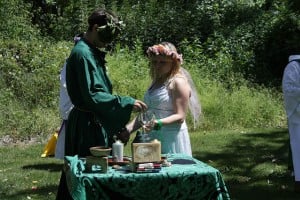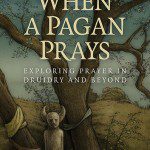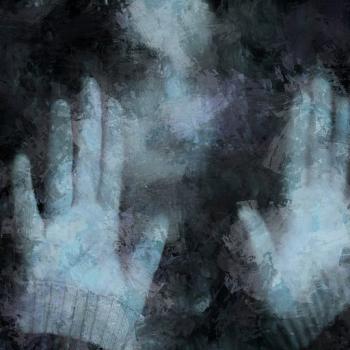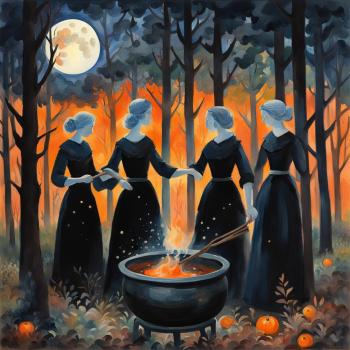When I was trying to figure out what to write for this column, a coven mate suggested that I write about gender and polarity. My first reaction was something along the lines of, “What, really? Really? Isn’t that all over with now?” He reminded me that whilst it might not be an issue in the bubble that is the San Francisco bay area, it’s still very much an issue elsewhere. He also reminded me that dealing with this very issue was one of the founding intentions of our own coven.

In many traditions, particularly in lines descended from Gardnerian and Alexandrian British Traditional Witchcraft, it is common to assign particular roles split along gendered lines. Typically, men would initiate women, women would initiate men, the High Priestess rules all. Couples would typically work together and would be either initiated together or expected to initiate each other. Gendered polarity was also directly reflected in the ritual itself, with all that dagger-and-cup stuff. Oh what a Great Rite!
For those for whom this approach works, good on you. I’ve done my fair share of cupdaggering too. Things get a bit tricky, however, when people start suggesting that this is the only way to work. This is witchcraft, and if you’re doing something else, well, you’re not real witches. I’ve heard it said that gay people can’t possibly have magical power because all such power comes from the interplay of gendered polarity. I’ve heard plenty said about trans people that I won’t bother to repeat here, but suffice it to say that much of it is along the same lines.
From experience, no. It just isn’t so. Queer people make extremely good witches and magicians. So do straight people. But, is it really necessary to throw the polarity baby out with the inclusiveness bath water?
Meditating after a Kali invocation some years ago, the following poem came to me:
The Sword
“Teach me, Kali-Ma. What is my purpose?”
“You are a sword.
Swords can cut,
swords can cleave,
swords can divide,
swords can block,
swords can control,
swords can lead,
swords can command.
Yet, swords can never help.”
“If I were not a sword, what might I be?”
“You might be a shield.
Shields can protect,
shields can reflect,
shields can return force as like unto its source.
Yet, shields can never help.”“You might be a cup,
for cups are the repository of power.
They hold strength and space for others, never for themselves.
Cups can never help.”“You might be a flower,
for flowers carry beauty and truth,
and thus they illuminate the worlds.
Yet, they can never help.”
“Who then, teacher, can truly help?”
“Only thyself, child, only thyself.”
It took me quite a while to start to unpick the meaning, but eventually I realized that it was about polarity, but a kind of polarity that is not bound up in traditional ideas of straight gender roles. In this quadrupolar model, there are swords, shields, cups and flowers. At first sight, swords and shields might be thought of as male, with cups and flowers being female, but this actually doesn’t follow — indeed, making exactly that assumption is why traditional gendered polarity breaks down as a model. A sword is someone who is a warrior-leader. In Qabalistic terms, swords live in Geburah, with the Angel Khamael being the archetypal sword. A shield is a protector — they have the power to declare that, “None shall pass,” though they are not warriors in the usual sense of the word. A cup is someone who holds power, and who empowers others, but who asks little or nothing for themselves. A flower is a true leader, in the sense that they are someone who tends to be followed by others, whether they like it or not. In more familiar terms, a flower might be a bodhisattva — the Buddha himself, possibly.
Most people seem to primarily follow one of these archetypes, but may find themselves drawing upon one or more of the others from time to time. Particularly, someone might be a flower at heart, but they might find themselves called upon to be a sword because circumstances dictate that they must.
Swords, shields, cups and flowers are therefore the poles of this quadrupolar model. We’re more familiar with systems that have two poles — electricity, magnetism, not to mention the limited traditional idea of gender as male and female, but models with more than two poles aren’t precluded by this. Interplay between complimentary poles does hold power, as people who practice gendered magical polarity will attest. I would argue, however, that it is the interplay between poles that is key, not the association of the poles with genders, or indeed the number of poles in the system.
The second thing to take from the poem is that no sword, shield, cup or flower acting alone is likely to be very effective. Swords are powerful but vulnerable. Shields can protect, but lack the agency to effect change. Similarly, cups can empower others, but can’t do much for themselves. Flowers can lead, but what use is a leader with no followers? Put a sword and a shield together and you have a formidable force. Add a cup and this multiplies the effect. Add a flower and the whole group can act together with purpose and conviction.
There is another layer of meaning in the poem, however, and I believe this to be a warning of sorts. It is easy to be inflamed with righteousness and start to believe that because we are completely convinced that we are right and that our actions are necessary we are actually helping. Though the sword/shield/cup/flower idea is tremendously powerful, there is a danger that when the four poles come together that great change can be effected very rapidly.
An it harm none, do as ye will.
Queer of Swords is published on alternate Thursdays. Subscribe via RSS or e-mail!

















